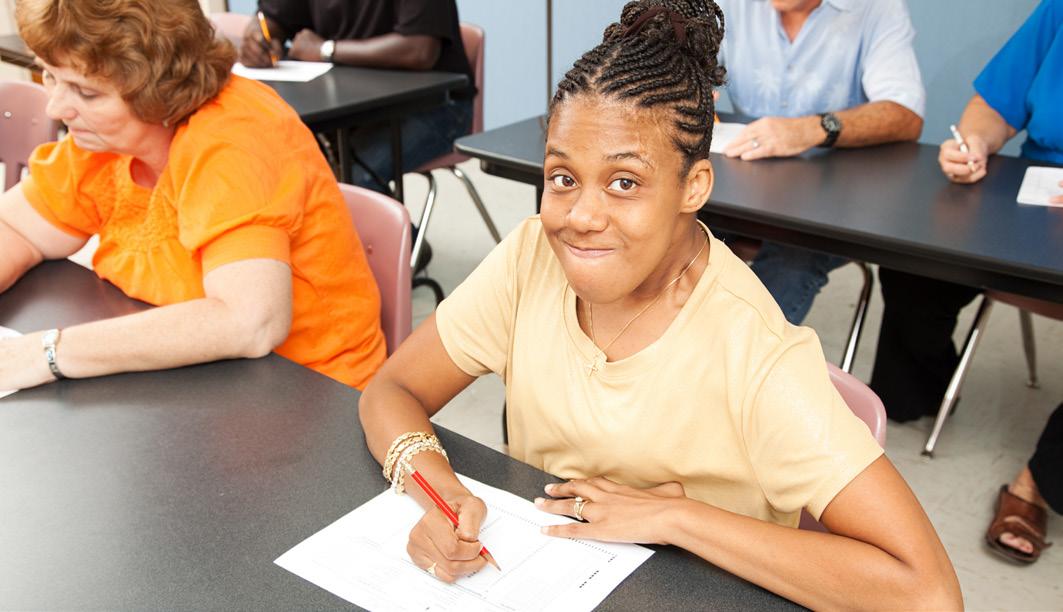
4 minute read
WHAT HAPPENS WHEN STUDENT SERVICES END: THE VANISHING IEP
What Happens When Student Services End The Vanishing IEP By Toby Tomlinson Baker
CHANCES ARE WE ALL KNOW A STUDENT WITH A DISABILITY. THERE ARE ABOUT SEVEN MILLION TEENS IN THE NATION WHO CURRENTLY HAVE AN INDIVIDUALIZED EDUCATION PROGRAM (IEP), THE DOCUMENT THAT IS WRITTEN ANNUALLY AND SPECIFIES THE EXACT SERVICES EACH STUDENT WITH DISABILITIES RECEIVES THAT HAS SUPPORTED THEM ALL THROUGH SCHOOL.
But the second these students graduate from high school and enter college, their IEP vanishes. Twelve percent of all students enrolled in college have disabilities. Many families wonder what happened to their child’s IEP. They ask, “How will my child receive the help they need during college? How can we deal with the ‘Vanishing IEP?’”
The protections for students with disabilities written in their IEPs are covered by the Individuals with Disabilities Education Act of 1975 (IDEA). This legislation no longer applies once a student with disabilities graduates from high school. So, if this law does not apply to post-secondary students with disabilities, what laws do apply?
The Higher Education Opportunity Act was enacted in 2008, which was the first time in 40 years legislation focused on postsecondary students with disabilities. In 2019, the Higher Education Act was reviewed for reauthorization, yet lawmakers in Washington reached an impasse. Even though there have been many changes in higher education impacting these students, no legislation has been amended.
Currently, there is no consistent mandated legislation protecting students with disabilities in higher education. Since the IDEA is obsolete, the Americans with Disabilities Act (ADA) seems to be the go-to for legislation in higher education. The ADA’s protections are very broad and do not apply specifically to students with disabilities.
Postsecondary students with disabilities need IEPs to have the same services as they had in high school. Not enough students with disabilities are making a successful transition from high school to college or other training programs. Students with disabilities enter college with the dream of graduating. Yet too many students are failing their classes, dropping out or, as experts say, “departing.” In fact, 72 percent of post-secondary students with disabilities departed last year!

Since many students with disabilities who enter colleges after high school do not want to be labeled, or perhaps wish to shed their disability, they refrain from utilizing self-disclosure for academic assistance. Furthermore, privacy laws such as the Family Educational Rights and Privacy Act (FERPA) prevent families from stepping in and assisting their college teens. However, even for students who disclose their disability, there are still many concerns in higher education that are ignored, such as testing accommodations, resources, and advocacy. One major issue is faculty support and their implementation of appropriate accommodations in the classroom and online setting.
Since changing the national law is time-consuming, particularly during a pandemic, there are things that can be done right now by higher education faculty. Higher education institutions can start by training all their faculty in disability studies. They can change their policies to have mandatory training on disability topics at least once a year. Furthermore, they could have a disabilities expert on-hand, besides their Accessibility Officer. They could establish faculty meetings with students with disabilities every semester and they can stress the importance of having a healthy faculty/student-with-disability relationship.
If the IEP was an approved document at all colleges and universities, these institutions would have much more information to provide better accommodations for their students. The stigma of students with disabilities and the retention rate would be reduced. If the IEP traveled to college, more students with disabilities would graduate!
As a researcher and PhD candidate at Pepperdine University, Toby Tomlinson Baker’s doctoral work focuses on higher education faculty training, self-advocacy for students with disabilities, and policy reform. She has 12 years of experience teaching Special Education. She is the recipient of LDA’s 2020 Sylvester Award and CHADD’s 2018 National Educator of the Year.
Email: tobytomlinsonbaker.net


Most approaches to enabling children with autism to speak either don’t work or alienate the child…or both. The Autism Language Launcher gives you something totally new: a step-by-step guide that ignites language lift-off by: Tapping into your child’s innate intelligence (often unrecognized by others) Going with your child instead of against your child Building the relationship necessary to inspire your child to want to communicate Giving you the tools instead of outsourcing them to someone who doesn’t care as much as you do Providing techniques that work with adults on the spectrum, too! If you are a parent, relative, professional, educator, or caregiver of a child or adult who is: not yet verbal, making some sounds, using some words, speaking in single words, or using two-word phrases, then this book is for you. In a caring, understanding, and deeply supportive way, author Kate C. Wilde uses her decades of experience with children and adults on the spectrum to show you how to break through and finally enable your child to: Begin speaking and communicating Build their vocabulary…willingly Expand sounds into words and words into phrases Ask and answer questions Construct their own original sentences (rather than simply repeating rote phrases) Share their thoughts In addition, you’ll learn to effectively address your child’s echolalia, repetitious language, and repetitive questions (without scolding your child, stopping your child, or “doing battle” with your child) in a way that your child will find supportive, bonding, and even joyful.











